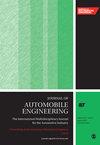基于人机交互的自动驾驶汽车智能纵向控制策略
IF 1.5
4区 工程技术
Q3 ENGINEERING, MECHANICAL
Proceedings of the Institution of Mechanical Engineers Part D-Journal of Automobile Engineering
Pub Date : 2024-04-13
DOI:10.1177/09544070241242831
引用次数: 0
摘要
在可预见的未来,智能汽车有望过渡到智能驾驶系统与人类驾驶员无缝协作的模式。驾驶员与智能控制系统之间的这种和谐融合对于成功执行驾驶任务具有至关重要的意义,最终将有助于开发出更先进、更人性化的汽车。从辅助驾驶推进到自动驾驶的关键因素在于建立人机共驾模式。本研究为具有人机交互功能的智能汽车量身定制了一种纵向控制策略。该方法包括通过收集驾驶员特征参数,创建个性化的跟车安全距离模型。本研究以汽车跟车方法为重点,制定了运动学状态空间方程、性能指标函数和制约汽车跟车动力学的约束条件。随后,基于模型预测控制(MPC)设计了汽车跟随控制策略,并通过滚动优化技术加以解决。在此基础上,提出了一种人机驾驶控制策略,用于实时动态分配驾驶权限。该策略将速度和车距风险作为二维输入,在双驱动双控制系统中采用了合作驾驶控制策略。所提出的方法在模拟环境中得到了验证。本文章由计算机程序翻译,如有差异,请以英文原文为准。
An intelligent human-machine interaction-based longitudinal control strategy for autonomous vehicles
In the foreseeable future, the anticipation is that intelligent vehicles will transition to a mode where the intelligent driving system collaborates seamlessly with the human driver. This harmonious integration between the driver and the intelligent control system holds paramount significance for the successful execution of driving tasks, ultimately contributing to the development of more advanced and user-friendly automobiles. A pivotal element in advancing from assisted to autonomous driving lies in the establishment of a human-machine co-driving mode. This research delineates a longitudinal control strategy tailored for intelligent vehicles featuring human-machine interaction. The approach involves the creation of a personalized safe distance model for car-following by collecting driver characteristic parameters. Focused on the car-following methodology, this study formulates the kinematics state space equation, performance index function, and constraint conditions governing car-following dynamics. Subsequently, a car-following control strategy is devised based on model predictive control (MPC), which is addressed through rolling optimization techniques. Building upon this foundation, a human-machine driving control strategy is proposed to dynamically allocate driving authorities in real-time. This strategy takes into account speed and vehicle distance risk as two-dimensional inputs, employing a cooperative driving control strategy within the dual-drive dual-control system. The proposed method was validated in a simulated environment.
求助全文
通过发布文献求助,成功后即可免费获取论文全文。
去求助
来源期刊

CiteScore
4.40
自引率
17.60%
发文量
263
审稿时长
3.5 months
期刊介绍:
The Journal of Automobile Engineering is an established, high quality multi-disciplinary journal which publishes the very best peer-reviewed science and engineering in the field.
 求助内容:
求助内容: 应助结果提醒方式:
应助结果提醒方式:


